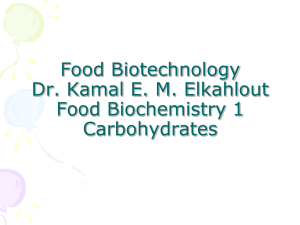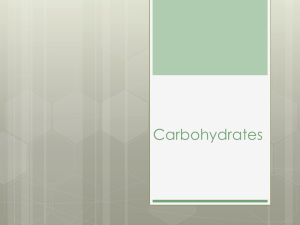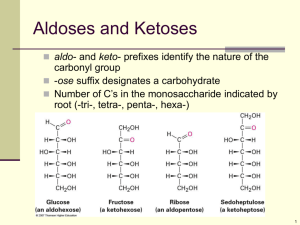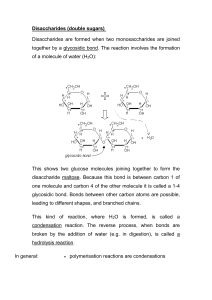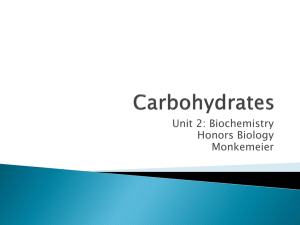Maltose 2 glucose units (α 1
advertisement
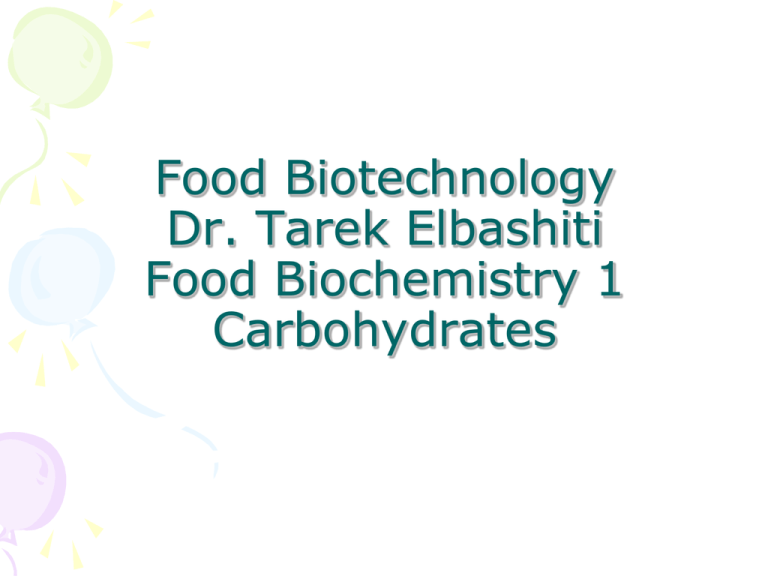
Food Biotechnology Dr. Tarek Elbashiti Food Biochemistry 1 Carbohydrates Carbohydrates • Comprised of > 90% of dry matter of plants • Abundant, widely available and inexpensive • Common components of food – As natural components and added ingredients • Commonly consumed in quantities and varieties of products • Different molecular structures, size and shape – Exhibit variety of chemical and physical properties • Therefore amendable in both chemical and biochemical modification to improve properties and extending uses Chemical nature (Carbonyl) 1 1 2 Aldose and ketose • Aldose: • An aldehyde • is an organic compound containing a terminal carbonyl group. This functional group, which consists of a carbon atom which is bonded to a hydrogen atom and double-bonded to an oxygen atom (chemical formula O=CH-). – Also called the formyl or methanoyl group. • Ketose: – A ketone • either the functional group characterized by a carbonyl group (O=C) linked to two other carbon atoms or a chemical compound that contains the functional group. Glucose Fructose Galactose ` Disaccharides • 2 monosaccharide units joined together – 2 sugar units – Maltose • 2 glucose units (α 1-4 linkages) – Cellobiose • 2 glucose units (β 1-4 linkages) – Lactose • Galactose + glucose (β 1-4 linkages) – Sucrose • Glucose + fructose (α 1-2 linkages Glycosidic Bonds • Formed between the free carbonyl group of one monosaccharide and a hydroxyl group of another monosaccharide • Readily hydrolyzed by – Heat and acid – Certain enzymes such as sucrase,invertase, amalyaes Maltose • also known as malt sugar • actual name = 4-O-(a -Dglucopyranosyl)- a -D-glucopyranose • obtained by enzyme-catalyzed hydrolysis of starch • composed of two D-glucopyranoses • 1,4’-a -glycoside bond (1,4’-a linkage) • reducing sugar, contains hemiacetal function and can mutarotate • easily digested by humans Lactose • milk sugar (both human and cow) • actual name = 4-O-(b -D-galactopyranosyl)-b D-glucopyranose • milk sours when lactose is converted to lactic acid (tastes sour) • composed of D-galactose and D-glucose • 1,4’-b -glycoside bond (1,4’-b -linkage) • digested by most humans, lactose intolerant individuals often lack the enzyme, lactase, which hydrolyzes the glycosidic linkage. If a person becomes lactose intolerant, they often they quit producing lactase, or it becomes ineffective. • reducing sugar Sucrose • Table sugar (from sugar beets or sugar cane) • actual name = 2-O-(a -D-glucopyranosyl)-b -Dfructofuranoside • Composed of one glucose and one fructose molecule • "invert sugar" is produced by the hydrolysis of sucrose. The hydrolysis produces a 1:1 mixture of glucose:fructose. • This is called "invert sugar" because the optical rotation changes from +66.5o to -22.0o upon hydrolysis. • 1.2’-glycoside linkage (beta-D-fructoside and alphaD-glucoside) • Not a reducing sugar, no free hemiacetal, this implies both glucose and fructose must be glycosides Reducing Sugars • Contain a free carbonyl group • All monosaccharides are reducing sugars • Disaccharides are reducing sugars only if they contain a free carbonyl group • Sucrose is not a reducing sugar-carbonyl group of both glucose and fructose is involved in the glycosidic bond. • Reducing sugars give brown colors to baked goods when they combine with free amino acids-Maillard reaction. Oligosaccharides • 3-10 sugar units • Important oligosaccharides – raffinose and stachyose. – Composed of repeating units of galactose, glucose and fructose – nutritional importance because they are found in beans and legumes. – unique glycosidic bonds – raffinose and stachyose cannot be broken down into their simple sugars. • therefore, they cannot be absorbed by the small intestine and are often metabolized by bacteria in the large intestine to form unwanted gaseous byproducts. • commercial enzyme preparations such as Beano can be consumed before a meal rich in beans and legumes in order to aid the small intestine in the breakdown of these oligosaccharides. Polysaccharides or complex carbohydrates • More than 10 units of sugar • Usually monomers and consist of thousands of repeating glucose units. • Allow for the storage of large quantities of glucose. • Starch is the major storage form of carbohydrate in plants and has two different types: amylose and amylopectin. • Although digestible alpha glycoisidic bonds link both types of starch, each type is unique in their branching of glucose. – amylose is a straight chain polymer – amylopectin is highly branched. • These differences account for the fact that – amylopectin can form stable starch gels which are able to retain water – while amylose is unable to do so. » Therefore, amylopectin is often used by manufacturers to produce many different kinds of thick sauces and gravies. Sources of starch include potatoes, beans, bread, pasta, rice and other bread products. Amylose • several hundred glucose molecules with 1,4’-a -glycoside bonds • molecular weight of 150,000 to 600,000 • 1000 to 4000 glucose units per molecule • little or no branching • chains coil in the form of a helix. In the Iodine test, I2 molecules fit into the helix and causes the intense blue color Amylopectin • more complex than amylose • 1,4’-a -glucose linkages for the main polysaccharide chain • 1,6’-a glycoside linked branches approximately every 25 units • very complex 3-d structure • up to 1 million glucose units per molecule Indigestible polysaccharides • Dietary fiber and come in many different forms including cellulose, hemicellulose, pectin, gum and mucilage. • Cellulose is by far the most abundant biochemical compound on the earth – because it forms part of the structure of many plants. – unique among polysaccharides in that it forms intramolecular hydrogen bonds between adjacent glucose units as well as beta 1,4 glycosidic bonds present in other carbohydrates. – these special bonding characteristics allow cellulose to form long, straight chains of glucose and give it strength and rigidity that many plants require for proper growth. – Cellulose and most forms of hemicellulose are insoluble fibers while pectin, gum and mucilage are all soluble fibers and readily dissolve or swell when mixed with water. Tutorial 1. Define the following and give an example of each: a. Monosaccharides b. Disaccharides c. Polysaccharides 2.Differentiate between: a. aldose and ketoses. b. Amylose and amylopectin 3. What is lactose intolerance? 4. Why can’t we use galactose? 5. What is galactosemia?
